 Michael Porter, the famed professor of strategy at Harvard Business School, says strategy is deliberately choosing a different set of activities to deliver a unique mix of value and that in turn must drive superior economic returns for sustainable competitive advantage (ref.). That’s a mouthful, to be sure, but to see this in action, one need look no further than Burberry who has completely remade themselves and is seeing double digit earnings growth. But how do you do this when it comes to shopper marketing? And will you do it? Your CEO wants you to. Here’s your agenda.
Michael Porter, the famed professor of strategy at Harvard Business School, says strategy is deliberately choosing a different set of activities to deliver a unique mix of value and that in turn must drive superior economic returns for sustainable competitive advantage (ref.). That’s a mouthful, to be sure, but to see this in action, one need look no further than Burberry who has completely remade themselves and is seeing double digit earnings growth. But how do you do this when it comes to shopper marketing? And will you do it? Your CEO wants you to. Here’s your agenda.
Realign – Start with strategy and check critical points of alignment. Does the shopper marketing strategy align with the overall marketing strategy? And does that marketing strategy align appropriately with the strategy for the line of business and in turn with the overall business strategy? And, most importantly, does the strategy lead to sustainably superior results? If it does, you pass this test and can move on. If it doesn’t, you’re probably stuck in the mode of what Porter calls “competing to be the best” (vs. different) and you have some strategy work to do.
Redesign – Start with an End-to-End™ assessment and create a map that includes everyone and every organization that’s part of the shopper marketing system (unfortunately, most shopper marketers don’t have this map of their core activities). Then “walk the process” backwards from the consumer back to the strategy. What’s on strategy and what’s not? Which activities add value and which don’t? Are you investing and innovating in activities that create a unique mix of value for shoppers? If not, what are the obstacles? Get rid of everything that isn’t creating value (60% or more of everything you’re now doing). Get rid of it now. Then redesign the system to achieve your newly aligned strategy.

Innovate – Now that you’ve cleaned house, you have the resources to redeploy to new shopper marketing platforms that deliver a unique mix of value for your consumers. But treat every new idea just like you would if you were building a new product portfolio. It has to deliver value. It has be on strategy. It has to fit with everything else in the shopper marketing portfolio so that the whole is greater than the sum of the parts. And importantly, it has to lead to sustainably superior results. These new shopper marketing innovations need to be qualified, developed and commercialized just as you would any new product.
There you have it: the leadership agenda for superior shopper marketing. If the old world of marketing is dead, and it’s probably at least dying, then you need to create the new world. You need to redesign shopper marketing so it delivers real value for consumers and economic value for your business. More of the same old same old just isn’t going to cut it unless you’re content with competing to be the best (which leads to competitive convergence) and not really that concerned with what Harvard Business professor Youngme Moon calls in her book Different “escaping the competitive herd”. But if you are interested in competitive advantage, then it’s going to take effort to realign, redesign and innovate.
(Larry McManis is President & CEO of ThinkWay Strategies, a business design agency that focuses on helping companies reinvent themselves internally to meet the growing challenges they face externally. He frequently writes for other businesses and organizations including the Shopper Insights in Action Conference sponsored by IIR USA.)